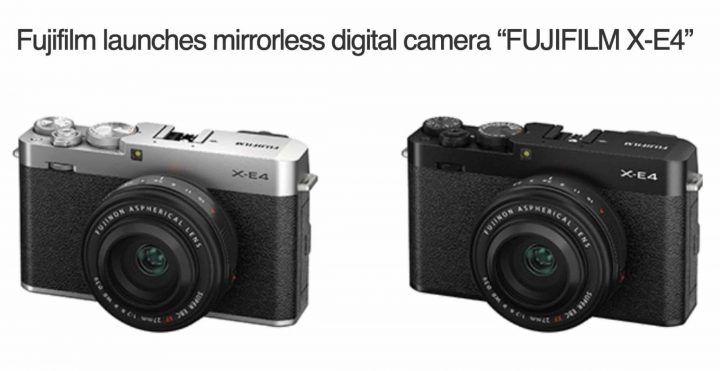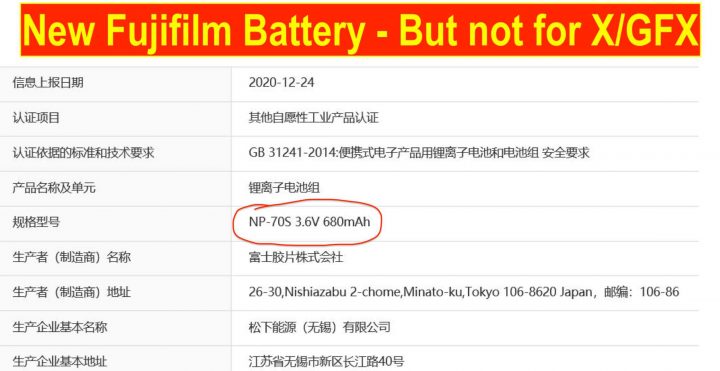
Fujifilm launches mirrorless digital camera “FUJIFILM X-E4”
– The compact and lightweight mirrorless digital camera for X Series with the fourth-generation sensor and image processing engine
– A classically-designed beautiful camera body featuring the fast and accurate AF as fast as 0.02 seconds
– Superb operability to make it comfortable to take high-quality image with proprietary color reproduction
TOKYO, January 27, 2021 — FUJIFILM Corporation (President: Kenji Sukeno) is pleased to announce the launch of the mirrorless digital camera “FUJIFILM X-E4” (X-E4) in late February 2021, the latest model to join the X Series of compact and lightweight digital cameras, known for superior image quality delivered with the company’s proprietary color reproduction technology.
The X-E4 is the most compact and most lightweight of all mirrorless digital cameras equipped with the Series’ fourth-generation image sensor and image processing engine. The beautiful camera body in a classical design carries a fast and accurate autofocus (AF) as fast as 0.02 seconds. It boasts exceptional operability, producing high-quality images with the company’s proprietary color reproduction technology.
The X-E4 is a mirrorless digital camera that caters to a wide range of lifestyles and situations, making it a perfect choice for those who want to carry a camera around anywhere and anytime to enjoy photo shootings of an advanced quality.
The compact X-E4 offers exceptional portability, weighing approximately 364g*, or approximately 448g even when it is mounted with the standard prime lens “FUJINON Lens XF27mm R WR,” also announced today.
The X-E4’s beautifully classical body features the 26.1MP “X-Trans™ CMOS 4”** sensor and the high-speed “X-Processor 4” image processing engine, which are also featured in models including the X Series’ flagship model “FUJIFILM X-T4.” Its fast and accurate AF can attain focus in as fast as 0.02 seconds, ensuring that users capture decisive photo opportunities. The camera can deliver diverse photographic expressions with Fujifilm’s Film Simulation modes, replicating the colors and tones characteristic of the company’s films such as the photographic film “Velvia” and motion picture film “ETERNA.” Users can take advantage of excellent color reproducibility, nurtured for more than 80 years, to enjoy high-quality photography with ease thanks to exceptional operability attributable to features such as the LCD monitor that can be flipped upward to 180 degrees and the Shutter Speed Dial.
Fujifilm will continue to deliver photographic pleasure through the X Series of mirrorless digital cameras such as the X-E4 and an extensive lineup of interchangeable lenses for the Series including the standard prime lens “FUJINON Lens XF27mm R WR” and the ultra telephoto zoom lens “FUJINON Lens XF70-300mmF4-5.6 R LM OIS WR,” also announced today.
- * Including a battery and a memory card.
- ** X-Trans is a trademark or a registered trademark of Fujifilm.
1. Product features
(1) Compact and lightweight camera body in a stunning design
- The rear LCD monitor can be stored flush in the back panel. The result is the most compact (W121.3mm x H72.9mm x D32.7mm) and most lightweight (approximately 364g) model among mirrorless digital cameras equipped with the X Series’ fourth generation image sensor and image processing engine. It can be carried anywhere in a bag for outstanding portability.
- The top panel is made of magnesium, a highly rigid metal that is difficult to process. The use of a high-precision mold has led to sharp and streamlined edges. Both the front and rear grips are flat to create a beautifully classical design which reminds the traditional film cameras.
(2) Equipped with the latest image sensor and image processing engine
- The X-E4 is equipped with the back-illuminated 26.1MP “X-Trans™ CMOS 4” sensor with on-sensor phase detection pixels as well as the “X-Processor 4” high-speed image processing engine to enable fast AF as fast as 0.02 seconds. This ensures users capture decisive moments, making it a powerful tool for snapshots.
- The camera features a highly accurate tracking AF system, capable of accurately tracking a subject that is moving either toward the camera or away from the camera. Its exceptional Face / Eye Detection AF function keeps a moving subject’s face / eyes in focus, allowing users to focus on framing while shooting.
- The AF system can operate in low light conditions, even in near darkness at -7.0EV***, attaining an accurate focus in poorly-lit indoors.
- *** The minimum AF luminance of -7.0EV is achieved when the camera is mounted with the FUJINON Lens XF50mmF1.0 R WR.
(3) Fujifilm’s unique Film Simulation for diverse photo expressions
- The X-E4 offers a total of 18 modes in Fujifilm’s proprietary Film Simulation function, including the vivid and high-contrast “Velvia” and high-contrast yet low-saturation “ETERNA Bleach Bypass,” which simulates the “bleach bypass”*4 darkroom technique to produce a solemn atmosphere. Users can pick and choose different styles to suit a subject or shooting scene as if to remove and insert a different roll of photographic film. Colors and tonal effects can be checked on the LCD monitor or the viewfinder, contributing to shortening time required for post-processing.
- *4 One of the processing techniques for developing photographic films.
(4) Superior operability
- The X-E4 features a tilting rear LDC monitor, accommodating various shooting styles, from high and low angles. The monitor can be flipped 180 degrees upwards for easy self-portrait.
- The top panel of the camera body has the Shutter Speed Dial, allowing users to check the shutter speed setting without having to turn the camera on and smoothly move on to the next shots. This camera’s Shutter Speed Dial newly features the Program (P) position, in which the camera automatically chooses the optimum combination of shutter speed and aperture settings to take high-quality images with ease.
- The functions offered by the rear dial in the current model, FUJIFILM X-E3, are reassigned to the front dial to secure enough space for resting the thumb when holding the camera for comfort and streamlined operation.

(5) Extensive video-recording functions
- The X-E4 generates 4K video from the amount of data equivalent to 6K to ensure the footage is in high resolution with low noise. It supports recording 4K/30P video at 8-bit 4:2:0 onto an SD card inserted in the camera, and outputting 4K/30P video at 10-bit 4:2:2, containing greater color information, via the HDMI port.
- The camera is also capable of high-speed Full-HD recording at 240fps, producing up to 10x slow-motion footage of a split-second motion of a fast-moving subject.
2. Optional accessories
(1) Leather case “BLC-XE4” (designed specifically for the X-E4)
This is a genuine leather bottom case that provides protection to the camera body while accentuating its stunning linear design. Its advanced features include the ability to change the battery without having to remove the camera from the case.
(2) Hand grip “MHG-XE4” (designed specifically for the X-E4)
This metal hand grip makes it substantially more comfortable to hold the camera. It helps reduce camera shake when shooting with a large-aperture lens. The camera’s battery or SD card can be replaced without having to remove the hand grip.
(3) Thumb rest “TR-XE4” (designed specifically for the X-E4)
This metal thumb-resting grip is installed at the top part of the camera body, providing a thumb rest for a firm grip. The part where the thumb comes in contact is coated with rubber non-slip strip to control camera shake even when shooting with one hand. Users can rotate camera dials without having to remove the TR-XE4, offering operating comfort and enhanced grip at the same time. It is available in black or silver to match color variations of the X-E4.














